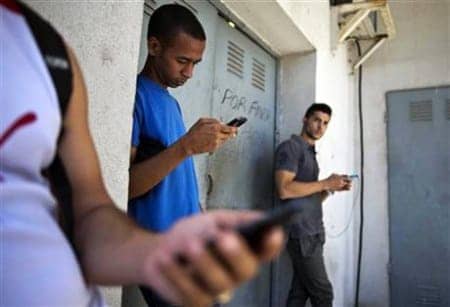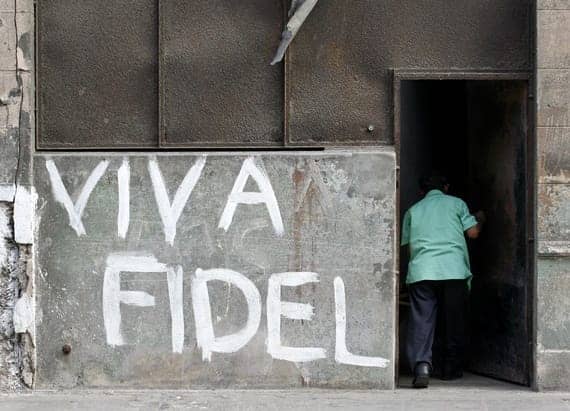by Harold Green
The recent revelations about the USAID’s farfetched scheme to foster a popular anti-government protest movement by infiltrating Cuba’s mobile phone network perhaps bring full circle America’s 55-year campaign to destroy the Cuban Revolution. Fortunately for the people of Cuba, none of these bewildering, hairbrained and often violent schemes – which have included countless attacks on Cuban soil – have succeeded. The most notable, of course, being the disastrous CIA sponsored 1961 Bay of Pigs invasion. Still, these failed attempts have resulted in the loss of thousands of Cuban lives.
This obsession with destabilizing Cuba or wanting to assassinate Fidel Castro has been constant, and every failure has begotten another compulsive craving to topple a government that successive American administrations have misguidedly perceived to be an enemy. The long list of CIA futile attempts to assassinate Fidel Castro has now become a running joke, not just in Cuba but in the world in general.

It should be noted, however, that long before Fidel Castro, U.S. had this obsession with Cuba. With the hope of making it part of U.S. territory, President William McKinley intervened in the Cuban War of Independence against Spain on April 25, 1898. The resulting Spanish American War saw the U.S. defeating Spain and taking control of the island. The U.S. had no intentions of ever relinquishing power in Cuba despite agreements stating it would respect Cuba’s sovereignty.
The constitution and government it would eventually set up would lead to elections which excluded Afro-Cubans and women – and leave in place a government that answered to Washington’s demands. With the signing of the Platt Amendment in 1901 and the new Cuban government incorporating it into its constitution, the U.S. gained carte blanche access to Cuba’s resources and land, as well as control over its foreign policy. The Platt Admendment would also result in the U.S being allowed to set up a naval base in the province of Guantanamo.
When Fidel Castro and the July 26 Movement came to power on Jan. 1, 1959, they ended U.S. control of Cuba’s resources and nationalized foreign-owned companies. Fidel Castro would initiate agrarian reform, close the casinos, end legalized prostitution, provide free healthcare and education to the Cuban masses, and pass laws outlawing discrimination against Afro-Cubans.
American companies and the many American officials who had investments in them – like the Dulles brothers, Alan and John Foster, who at the time respectively ran both the CIA and State Department – were none too happy. America’s Caribbean obsession, which began in 1898, became more compulsive after 1959. With the loss of its most prized Caribbean possession – left with just Puerto Rico and the U.S. Virgin Islands – America’s official foreign policy towards Cuba became obsessively geared toward destabilization, overthrow and assassination.
Even when the U.S. appears to be backing off of this obsession by modifying its foreign policy toward Cuba, it doesn’t take long to realize, after reading the official policy documents, that nothing has changed. The Obama administration’s latest example of this, the altruistic sounding People to People Program, which makes it easier for Americans to travel to Cuba – albeit with restrictions – is nothing more than a destabilization program by other means.
With its emphasis on “people to people” contact, it is the hope of the Obama administration to have Americans go to Cuba and influence ordinary Cubans to turn against the Cuban government. The Cuban officials are too smart to be taken in by such schemes, of course, and while willing to take advantage of whatever benefits that are to be derived from such policy changes, closely monitor American behavior in Cuba and, more often than not, are able to minimize would be negative effects and often catch would be spies.
America’s Caribbean obsession, which began in 1898, became more compulsive after 1959. With the loss of its most prized Caribbean possession, America’s official foreign policy towards Cuba became obsessively geared toward destabilization, overthrow and assassination.
The recent AP report revealing USAID’s plan to propagandize young people in Cuba, using a secret social network, Twitter and text messaging, is an obvious manifestation of the People to People Program with its emphasis on licensing Americans who are telecommunications contractors to set up operations in Cuba. Given the surreptitious nature of these policy changes over the years, one begs the question, will the U.S. ever give up its obsession with trying to topple the Cuban government and start engaging in honest attempts to normalize relations with one of its closest neighbors in the region?
The U.S. embargo against Cuba, which partially began in 1960 and became full fledged on Feb. 7, 1962, was meant to destroy Cuba’s socialist economy. It has not resulted in its intended effect. A growing number of Cuban exiles, especially among the young, are growing weary of a policy that needlessly strains relationships between them and fellow Cubans on the island.

With many of the old anti-Castro Miami based Cuban guard – though still very vocal – dying off, this younger generation is anxious to reestablish contact and take advantage of investment opportunities the Cuban government has allowed since it began to gradually open up the Cuban economy starting in the mid 90’s. The Cuban government now allows Cubans living abroad to participate. On March 29, President Raul Castro announced that investment opportunities in Cuba will become even more liberalized
USAID, obviously undeterred by these new developments or the fallout from the arrest of USAID worker Alan Gross who, in 2009, was arrested in Cuba for secretly passing out communications equipment and was sentenced to 15 years in prison for espionage, since the AP story broke, has defended its position, claiming that it was not a covert operation because it was approved by Congress, says USAID administrator Rajiv Shah.
Despite criticism coming from members of Congress who were not aware of ZunZuneo – the name given to this operation – Shah insists that the purpose of the program was to help spread democracy and allow Cubans to more freely communicate with one another. Still, many ask, is this the appropriate role for an agency whose stated purpose is to aid in humanitarian assistance and economic development? White House press secretary James Carney, in following Shah’s comments, said the program was secret “not because it is an intelligence program, but to protect individuals.” People can draw their own conclusions from such convoluted reasoning.
Cuban officials, not having been informed about the project and remembering USAID’s earlier clandestine attempts to spread “democracy” in the island, including the Alan Gross affair, had become suspicious in 2011 that the Twitter scheme would be used to undermine the Cuban government.
The U.S. long running circus of sabotage and espionage against Fidel Castro’s Cuba, whose anti-Castro Cuban ringleaders have had U.S. officials, from the Eisenhower administration to now, virtually jumping through rings of fire as they lunged from one failed attempt to another to destroy a revolution which most of the 11 million Cubans are still willing to defend.
We do not know what fiasco this obsession will bring next. Certainly there will be another, for obsessives simply cannot control themselves. But fortunately for now, Fidel Castro, the Cuban Revolution and the beautiful, courageous people of Cuba are still standing, still defending their revolution.
And those of us who know Cuba, especially those of us in the African Diaspora who have not forgotten Cuba’s role in helping to end colonialism and apartheid in Africa, and who love the Cuban people for the justice and health they have helped bring to the world, will be standing with them.
¡Viva la Revolución Cubana!
A brief chronology of United States destabilization campaigns against Cuba
Since the Cuban Revolution, U.S. and Cuban exiles have been responsible for countless attacks, mostly bombing, against the Cuban government. Cuban officials estimate their have been no less than 600 CIA plots to assassinate Fidel Castro. Listed below is a brief listing of some of these earlier attacks and plots. For a more complete list, see Jane Franklin, “Cuba and the United States: A Chronological History.”
1959
Feb. 2: U.S. citizen Alan Mayer is arrested for flying a small plain into Cuba with the aim of assassinating Fidel Castro.
Oct. 11-21: Three raids by planes flying from the United States bomb sugar mills in Pinar del Río and Camagüey provinces. Cuba is making efforts to purchase planes for its defense.
Oct. 21: A plane raid on Havana results in two people being killed on the streets and 45 wounded.
Oct. 22: In Las Villas province, an airplane strafes a train full of passengers. Responding to such attacks, Cubans form popular militia.
1960
August: The CIA takes steps to recruit members of organized crime for help in assassinating Prime Minister Castro.
1961
April 17: The CIA’s invasion force, Brigade 2506, of some 1,200 men, invades at Playa Girón (Girón Beach) on the Bahía de Cochones (Bay of Pigs). (In Cuba, the Bay of Pigs invasion is known as the Battle of Girón.) The invaders are led and commanded by CIA agent Grayston (Gray) Lynch and CIA operative William (Rip) Robertson. The internal support anticipated by the CIA fails to materialize.
1962
Feb. 3: The Kennedy administration announces a total embargo of trade with Cuba to take effect Feb. 7.
Feb. 20: U.S. Gen. Landsdale presents to the SGA (Special Group Augmented, aka the Cuban Project or Operation Mongoose) a 26-page timetable for the overthrow of the Cuban government.
July-October: Several attacks from the U.S. Naval Base on Guantanamo kill Cuban citizens.
Learn more
http://guardianlv.com/2014/04/u-s-creates-fraud-twitter-to-force-democracy-in-cuba/
http://rt.com/news/cuba-usa-government-surveillance-101/
Harold Green is a pan-African activist living the Los Angeles. He can be contacted at paclwp@msn.com.





